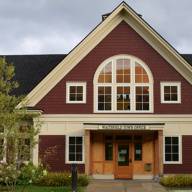By Mary Kathleen Mehuron
My husband, Tom Mehuron’s, paternal great-grandfather was Dr. Carlos Shaw, the Waitsfield town doctor. Gussie Graves, Fayston, told me she was born on the family farm that became the Green Mountain Valley School. Dr. Carlos trudged up Bragg Hill Road to deliver her and was paid in pigs. Three of them. But not all stories about him are good ones. Another member of a local family made sure to tell me he was a quack and a drunk. That her family would never think of going to him and found another doctor. All the stories I’ve heard about the man paint him as a colorful character. But I’d not heard a word about his wife Edith Grace.
I’ve been working very hard to collect stories about the historic women of the Mad River Valley. If you have any, please see my email below and contact me. For my part, I dug out the box of photographs and papers that Tom’s Aunt Ruth Mehuron McGill left behind. In it I found a manilla envelope that contained a written piece called “Life Sketch of Edith Grace Henderson Shaw.” I’d never seen it before.
Ruth begins by saying Edith Grace was born to James Herbert Henderson and Mary Issadore Delano on January 2, 1874, in Cleveland, Ohio. Her early life was filled with profound events -- both good and bad. Her brother Edward M. died two months after she was born. Brother Edward G. came along a year later but only lived to be a year old. One can only imagine the chaos that ensued in the household during this period. Although 15% of babies at that time died before their first birthday, the parental grief of losing two out of the three of their children must have been unbearable. The deaths could have been caused by prevalent diseases of the time: smallpox, diphtheria, measles, scarlet fever, or whooping cough. There were no vaccines for the illnesses back then.
But the family did welcome another daughter, Anna Maude, a few years later. They also joined in to celebrate the centennial -- the 100th anniversary of the United States of America. And perhaps it was the tragedy of the deaths of their two sons that made them want to pack up and move for a fresh start. In the 1870s tales were being told of gold and silver strikes in Colorado. This was followed by the development of railroads to those mining districts. By the late 1870s, there were more discoveries of both gold and silver in the San Juan Mountains, Gunnison Valley and Leadville, Colorado. Among those who went west to find their fortune were the Henderson family. Father James, Mother Mary Issadore, 6-year-old Edith Grace (who preferred to be called Grace) and her 3-year-old sister Anna Maude.
According to Aunt Ruth, they settled in the gold mining town of Cripple Creek. But in 1882 when Grace was 8 and her sister Anna Maude just turned 5, the girls waded out in the Cripple Creek to pick cattails. The younger girl struggled against the force of the river’s current and as Ruth says in her document, “Heartbreak again reached into a mother’s soul for Anna Maude drowned.
“The next trace I find of Edith Grace is in St. Joseph’s Academy in Binghamton, New York.” This was a boarding Convent School in upstate New York -- 177 miles from her parents. They had taken an apartment at 101 West 48th Street in New York City. According to History101, “The 1880s marked a transformative decade for New York City, characterized by significant advancements in technology, infrastructure, and culture. This era was highlighted by the completion of the Brooklyn Bridge in 1883, an engineering marvel that bridged Manhattan and Brooklyn. In 1886, the unveiling of the Statue of Liberty further solidified New York City’s status as a global symbol of hope and opportunity.” So why send Grace away?
Grace mailed her parents a letter from St. Joseph’s Academy dated January 25,1885:
My dear Mama and Papa,
I received your kind and welcome letters Saturday and was very sorry to hear that you were sick. I also got a letter from Auntie and heard that Uncle Ned is better. Mama, we had a very pleasant time here Thursday we had a Fair. Boarders went and we had ice cream and candy and many other things.
I would like to see Cousin Rachel very much. I told Mother that she was coming to the Convent next. Give my love to Sister Lora and all the folks. Tell Papa that I have the book he bought for me the morning we went away from New York. Well now, I will close with love and kisses.
I am as ever your loving,
Grace
So, Grace received letters from home and family visitors and sounded upbeat. It seems there was a good reason that her parents wanted her in a good school, for James and Mary Issadore’s only surviving child was very bright. Ruth says, “She wrote in a beautiful hand for an 11- year-old child. She was also gifted in art and music. It became her privilege to study under Madam Monleith in London, England.” Imagine the commitment and sacrifice the family made to send her to England to study music. To send a tween-aged girl to Europe seems extraordinary to me. Amy BeacTah was a child prodigy of the time who lived in New Hampshire. She would go on to become one of the greatest composers of the 19th and 20th centuries. But even she wasn’t allowed to study in Europe -- which is what would have been typical for a male pianist and composer of the time. Views about what was appropriate for a woman in the 19th century were narrow. Yet our Grace was sent anyway.
That leaves me to ask one question: How talented was that girl? More on Grace’s life and how she wound up in Waitsfield next time.
Mehuron lives in Waitsfield. Contact her at













